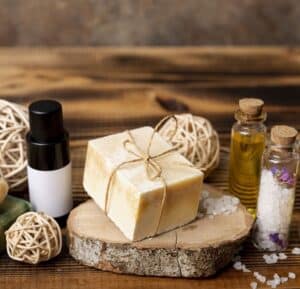Handmade soaps, whether made with a cold process, melted and poured, or made from natural plant ingredients, are admired for their creativity, authenticity and small productions. But despite their artisanal nature, these products are legally considered cosmetics in the European Union and must meet the same stringent safety requirements as industrially produced goods.
That means every handmade soap, no matter how simple the recipe, needs a Cosmetic Product Safety Report (CPSR) and proper microbiological testing to ensure it is safe for consumers. In this blog, we look at why handmade soap is subject to EU cosmetic rules, what safety documentation is required and how different types of soap bases bring unique compliance considerations.
The importance of safety for small batches and handmade soap
Recently, handmade soap has become super popular, especially among people who love eco-friendly, artisanal and natural personal care products. While small producers often emphasize transparency, inventiveness and craftsmanship, there is sometimes a misconception that “natural” is the same as “safe. In reality, handmade soap, whether made with natural plant ingredients, cast soap base or cold processes, falls under the same regulations as mass-produced cosmetics in the EU. This means that to be legally sold, they must meet the same standards for safety documentation, testing and compliance.
Because of their high pH, cold-pressed soaps are generally more stable, but there are still safety risks. Soaps with water-based ingredients, such as milk, honey, aloe vera or botanical extracts, can be prone to microbial growth, which can lead to spoilage and a danger to consumers. Despite their convenience, pouring soap bases often contain wetting agents that retain moisture, which can promote microbial growth if there are not enough preservatives. Despite their apparent simplicity, even natural or minimally processed soap blocks can contain vegetable ingredients that, if not handled properly, can degrade over time or cause microbial contamination.
Therefore, it is important to follow the rules when making soap responsibly, especially when it comes to the Cosmetic Product Safety Report (CPSR) and microbiological testing. By understanding and following these rules, artisan producers not only meet their legal obligations, but also improve their reputation, protect their customers and build a sustainable business that can grow with confidence in the EU market.
Understanding the EU cosmetics regulation
Definition of soap as a cosmetic product according to Regulation (EC) No. 1223/2009
According to Regulation (EC) No. 1223/2009, soap is legally considered a cosmetic product if it is marketed for cleansing or beautifying the skin. This definition includes virtually all cold-pressed, cast soap and natural handmade soap blocks intended for personal care. Some small-scale producers mistakenly believe that traditional soap-making methods exempt them from regulation, but the law makes no distinction between artisanal and industrial production. If the product is intended for personal use on the skin, it falls under the same regulations as lotions, shampoos or creams.
This classification has important implications. They require soapmakers to conduct safety assessments, maintain documentation and comply with labeling requirements. Whether they sell in a local market, online or through stores, compliance ensures that consumers receive products that are not only pleasant to use, but also safe. The recognition of handmade soap as a cosmetic product under EU law provides the basis for all further compliance measures.
Types of soap and specific safety considerations
Cold-pressed soaps: high pH and microbial resistance; should they be tested?
Many people consider cold-pressed soap to be the most “traditional” way to make soap. This soap has a naturally high pH (usually between 9 and 10) that is less conducive to microbial growth due to the saponification of oils and sodium hydroxide. Many soap manufacturers believe they are exempt from additional testing because of their natural microbial resistance. High pH soaps may be more stable than water-based cosmetics, but that does not mean they are immune to microbiological testing or CPSR.
Microbiological risk increases dramatically when cold-pressed soap contains ingredients such as goat’s milk, aloe vera or honey. These organic ingredients can shorten soap shelf life and reduce resistance to microbial growth. Therefore, toxicological profiles of all ingredients, a justification for the pH range and the results of microbiological testing in cases where water-rich ingredients are present should be included in a CPSR for cold-pressed soap. Testing provides documentation that supports compliance and demonstrates consumer safety even in cases where the risk of contamination is low.
Casting soap: added ingredients, water-based formulations and microbiological testing
Casting soaps use pre-made base ingredients that often contain glycerin and other humectants, which attract and retain water. This makes them particularly susceptible to microbial growth, especially when craft soapmakers add botanical ingredients, fragrances or exfoliants. Because cast base ingredients are water-rich, they require preservatives and strict hygiene during production. Without adequate precautions, these soaps can quickly develop microbial contamination, shortening shelf life and compromising safety.
Microbiological testing is therefore very important for cast soap formulations. Challenge tests, microbial limit tests and stability studies show whether preservatives work and whether the soap can withstand field use. In the CPSR, safety assessors must state why they chose a particular preservative system and assess how added ingredients affect microbial stability. For artisan soapmakers, this means striking a balance between creativity and compliance so that their products remain appealing and safe.
Natural/unrefined soap: plant ingredients, water content and need for preservatives
Consumers who care about the environment are big fans of natural or minimally processed soap. These soaps are unique in that they often contain unrefined oils, clays, vegetable ingredients or essential oils. However, these ingredients can cause problems. For example, unrefined oils may degrade more quickly than refined oils, and plant ingredients may contain microbial contamination from their natural habitat.
Soaps containing fresh plant extracts or water infusions are especially at risk.
Microbiological testing is super important for natural soap to ensure that contaminants are within limits. Stability data should also be included in the CPSR to demonstrate that the safety of the product over time is not compromised by these natural ingredients. Although regulatory agencies require the same level of safety assurance as for synthetic formulas, consumers value the authenticity of natural soap. Therefore, artisan producers must strike a balance between maintaining the authenticity of their products and complying with strict safety regulations.
Microbiological testing and CPSR documentation.
When is a preservative system needed and how should it be tested?
Not all handmade soap needs a preservative system. Cold-pressed soap without water-based additives probably does not need it because its high pH provides sufficient protection against microorganisms. However, soap containing water, fresh vegetable ingredients or glycerin may need a preservative system to remain safe. Safety evaluators determine this on a case-by-case basis when preparing the CPSR.
Testing checks whether a preservative system is effective. Challenge tests intentionally introduce microbes into a product to see if they remain under control over time, while microbial limit tests examine contamination in finished batches. For soap makers, these tests provide proof that their products remain safe during shelf life and under normal conditions of use. Including the results in the PIF strengthens compliance and protects consumers.
Suitable tests: challenge test, microbiological, stability
The three main categories of tests relevant to handmade soap are:
- Challenge tests: evaluate the effectiveness of the preservative system.
- Microbiological testing: check finished products for contamination.
- Stability testing: checking how the product holds up over time in terms of appearance, odor, pH and safety.
Each test contributes to a comprehensive safety profile. For cold-pressed soap, stability tests can focus on long-term pH consistency. For cast soap or natural soap blocks, microbial tests are especially important. By combining these tests, craft soapmakers can build strong documentation for their CPSR and PIF, demonstrating that their soap meets EU safety standards.
Compilation of safety assessment and PIF documentation for handmade soap
For small producers, gathering documentation is often the most difficult part. The PIF lists all relevant data, such as recipes, labels and test results, while the CPSR provides the official safety evaluation. Both documents must be verifiable by the government.
This means keeping supplier records, documenting each batch, and organizing test results for presentation. A well-prepared PIF ensures professionalism and transparency, even though it may seem like an administrative burden. By demonstrating that their products comply with the law, it also helps soap manufacturers avoid costly disruptions such as recalls or fines.
Practical steps for artisan soapmakers
Working with qualified safety assessors for CPSR
One of the most effective ways for small-scale manufacturers to comply is to work with qualified safety evaluators. These professionals compile the CPSR, review formulas and determine what tests are needed. For artisans, working with experts saves time and ensures accuracy, allowing them to focus on creativity while meeting regulatory standards.
Administration: batch logs, supplier data, test results
Proper record keeping is essential for compliance. Soap makers should keep batch logs with production dates, formulas and any deviations from standard procedures. Details of suppliers should be recorded to ensure traceability of raw materials, while test results should be stored as part of the PIF. This systematic approach not only helps with compliance, but also improves quality control and ensures consistency between products.
Labeling and claims: ensuring transparency and compliance
Labels must comply with EU requirements, including ingredient lists, responsible person details, batch numbers and shelf life information. Claims such as “natural,” “organic” or “suitable for sensitive skin” must be substantiated with data in the PIF. Misleading or unsubstantiated claims are prohibited and may result in regulatory action.
By focusing on accurate and transparent labeling, artisan producers build trust with consumers and meet compliance obligations.
FAQ: frequently asked questions for producers of CP, cast soap and natural soap
V1. Is microbiological testing always necessary for cold-pressed soap?
This is not always the case. The high pH provides natural resistance to microorganisms if no water-based additives are used. Any additional liquids or plant-based ingredients increase the testing requirements.
V2. Why is a CPSR required for handmade soap?
Because a CPSR is required to demonstrate the safety of all cosmetics sold in the EU, regardless of the scale of production. This ensures compliance with Regulation 1223/2009 and consumer protection.
V3. How do preservatives work in handmade soap?
In formulas that contain a lot of glycerin or water, preservatives protect against microbial contamination. A safety expert must determine whether they are needed based on the specific recipe.
V4. How long should the product information file (PIF) be kept?
To ensure accountability and traceability, the PIF must be updated for 10 years after the last batch of a product was placed on the market.
V5. Can I sell soap at a neighborhood market without a PIF or CPSR?
No. EU law must be followed no matter where or how the soap is sold. Artists risk financial and legal consequences when they sell without CPSR and PIF.
How YouWish can help
Handmade soaps, whether cold-pressed, melted and molded or natural, are loved because they exude creativity, authenticity and individuality. But like great cosmetics, they are also subject to strict EU cosmetics regulations. This means that CPSR and microbiological testing are not just formalities, but essential for protecting consumer health and building trust in your brand. By following EU Regulation 1223/2009 and keeping clear records of every step in your PIF, soap makers can sell their products with confidence without risk of legal or reputational damage.
At YouWish, we don’t just supply ingredients, we guide you through the process of making safe, compliant and high-quality soap. From providing the right essential oils and natural base ingredients to sharing information resources that help you understand CPSR, testing and labeling, we make sure your soap-making adventure is both inspiring and worry-free.
Want to take your handmade soap to the next level? Check out our range of soap supplies and essential oils at YouWish and find out how we can help you, from creation to compliance.

